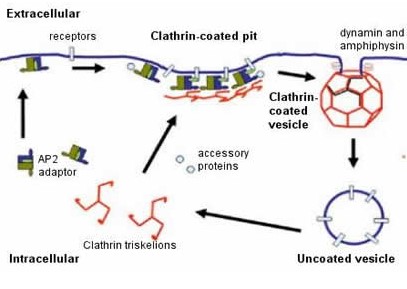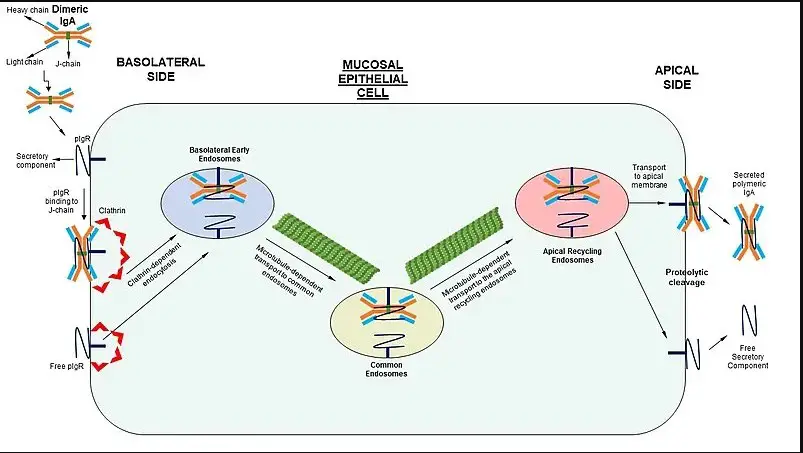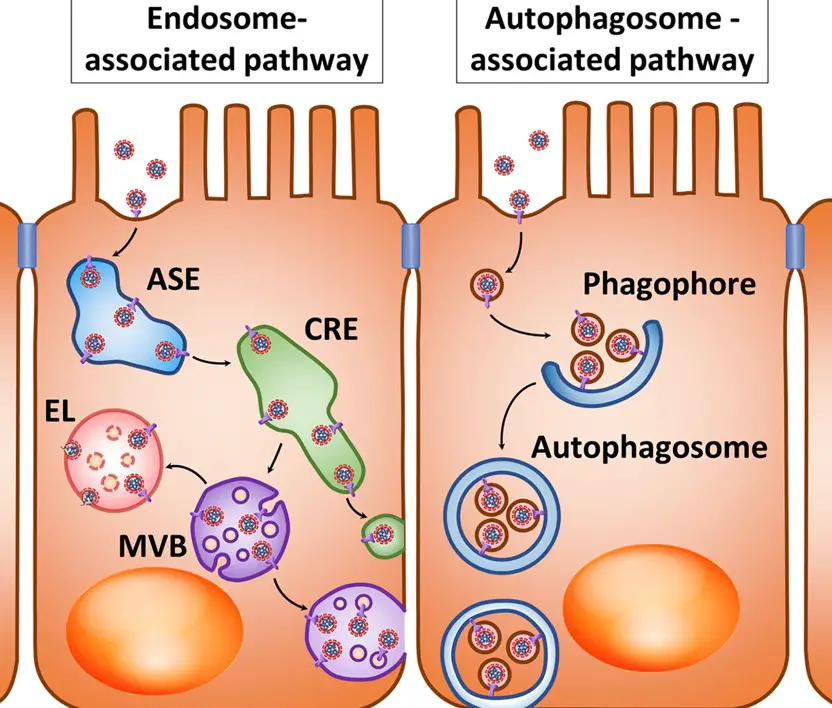Cellular transport mechanisms are the unsung heroes of our biological systems, playing a crucial role in maintaining homeostasis and enabling cells to perform their essential functions. Among these mechanisms, endocytosis and transcytosis stand out for their unique roles in transporting substances into and across cells. These processes are fundamental to how cells interact with their surrounding environment and regulate the internal composition of substances.
Endocytosis and transcytosis are distinct yet interconnected cellular processes. Endocytosis involves the cell membrane folding inward to encapsulate substances outside the cell, forming a vesicle that is brought inside the cell. Transcytosis, on the other hand, combines endocytosis and exocytosis to transport substances across the cell, from one side to the other, often traversing through the cellular barriers such as the endothelial cells of blood vessels.
Understanding these processes is essential for a deeper appreciation of how cells maintain their internal environments and communicate with their external surroundings. Endocytosis allows cells to engulf particles, ranging from nutrients to pathogens, thereby facilitating nutrient absorption, immune responses, and signal transduction. Transcytosis plays a critical role in transporting proteins and other macromolecules across cells, pivotal in processes such as antibody transfer and drug delivery. Together, these mechanisms showcase the complexity and dynamism of cellular life, reflecting the intricate balance and interdependence of biological systems.

Cellular Transport Overview
Cells are the building blocks of life, each acting as a bustling metropolis where materials constantly move in and out. This movement, crucial for survival, is governed by cellular transport mechanisms. These mechanisms ensure that essential nutrients enter the cell, waste products are expelled, and signals are communicated both within the cell and with its external environment.
Types of Transport Mechanisms
Transport mechanisms fall into two main categories: passive transport and active transport. Understanding these categories is key to grasping how substances traverse cell membranes, maintaining cellular health and function.
Passive vs. Active Transport
- Passive Transport: This process does not require energy. Substances move from an area of higher concentration to one of lower concentration, following the gradient until equilibrium is reached. Examples include diffusion, osmosis, and facilitated diffusion.
- Active Transport: Unlike passive transport, active transport requires energy, usually in the form of ATP (adenosine triphosphate). Substances move against their concentration gradient, from areas of low concentration to high concentration. This is essential for maintaining cellular concentrations of ions and molecules. Examples include sodium-potassium pumps and endocytosis.
Bulk Transport Mechanisms
For larger molecules or particles, cells employ bulk transport mechanisms: endocytosis and exocytosis. These processes involve the movement of substances in large quantities, encapsulated within vesicles, across the cell membrane.
What is Endocytosis?
Endocytosis is a form of active transport where the cell membrane folds inward to engulf extracellular substances, forming a vesicle. This vesicle then detaches and moves into the cell. It’s a critical process for nutrient absorption, defense mechanisms, and signal transduction.
Types of Endocytosis
Phagocytosis
- “Cell Eating”: Phagocytosis involves the ingestion of large particles or even whole cells, such as bacteria. It’s a key component of the immune response, allowing cells like macrophages to capture and destroy pathogens.
Pinocytosis
- “Cell Drinking”: Pinocytosis is the process by which cells take in extracellular fluids and small solutes. Unlike phagocytosis, it is not selective; the cell engulfs whatever is in the surrounding fluid.
Receptor-Mediated Endocytosis
- Selective Uptake: This process is more selective than phagocytosis or pinocytosis. Cells use receptors on their surface to bind specific molecules, such as nutrients or hormones, triggering vesicle formation. This ensures the cell takes in substances it specifically needs.
Mechanism of Endocytosis
The Role of the Plasma Membrane
The plasma membrane is not just a passive barrier; it actively shapes to form vesicles. This flexibility is crucial for endocytosis, allowing the cell to engulf substances from the outside environment.
Energy Requirement
Endocytosis requires energy in the form of ATP. This energy is necessary for the membrane to wrap around the substance and for the vesicle to pinch off and move into the cytoplasm.
What is Transcytosis?
Transcytosis combines elements of endocytosis and exocytosis to transport substances across the cell. It is pivotal in moving molecules from one side of the cell to the other, effectively crossing cellular barriers.
Combining Endocytosis and Exocytosis
- Definition and Overview: Transcytosis starts with endocytosis, where a substance is engulfed by the cell. The vesicle then traverses the cytoplasm and fuses with the opposite cell membrane, releasing its contents outside the cell through exocytosis.
Mechanism of Transcytosis
Vesicle Formation and Movement
- Vesicle Captures Substance: Through endocytosis, a substance is captured into a vesicle.
- Transport Across Cell: The vesicle moves across the cell, often along cytoskeletal “tracks”.
- Release of Substance: The vesicle fuses with the opposite membrane, and its contents are expelled via exocytosis.
Crossing Cellular Barriers
Transcytosis is especially important in crossing tight biological barriers, such as the blood-brain barrier or the intestinal epithelium. It allows essential nutrients, antibodies, and other molecules to pass through these barriers efficiently, ensuring proper physiological function.

Key Differences
Process and Purpose
Endocytosis and transcytosis serve distinct functions within the cellular landscape, despite their superficial similarities. The primary difference in their mechanisms lies in their end goals and processes.
- Endocytosis is primarily concerned with the intake of substances from the cell’s exterior environment. It allows cells to absorb nutrients, defend against pathogens, and regulate surface receptor levels, contributing to signal transduction and cellular communication.
- Transcytosis, in contrast, is involved in the transport of molecules across cells, effectively moving substances from one side to the other. This mechanism is critical for transporting molecules across tight biological barriers, serving functions not achievable by simple endocytosis.
Energy Consumption
The energy requirements of endocytosis and transcytosis also differ, given their distinct processes.
- Endocytosis requires ATP to facilitate the invagination of the plasma membrane and the formation of vesicles. This energy is essential for the active transport components of the process, where molecules are moved against their concentration gradient.
- Transcytosis not only encompasses the energy requirements of endocytosis but also includes the additional energy expenditure associated with the vesicle’s movement across the cell and its subsequent exocytosis. This dual-phase process implies a higher overall energy consumption.
Biological Implications
Role in Nutrient Absorption
- Endocytosis plays a vital role in the cellular uptake of essential nutrients. By allowing cells to engulf particles and fluids, it facilitates the absorption of vitamins, minerals, and other crucial nutrients from the extracellular environment.
- Transcytosis is especially significant in the absorption of nutrients that cannot passively diffuse across epithelial barriers, such as in the gut lining. It ensures that nutrients, once absorbed by enterocytes, can be efficiently transported into the bloodstream.
Implications for Drug Delivery
Both endocytosis and transcytosis have profound implications for drug delivery systems.
- Endocytosis can be exploited to enhance cellular uptake of medication, especially in the form of nanoparticles or liposomes that can be engulfed by cells.
- Transcytosis offers a promising route for delivering drugs across otherwise impermeable barriers, such as the blood-brain barrier (BBB). By designing drugs that can hijack this pathway, researchers can target medications to specific sites within the body more effectively.
Applications and Significance
In Health and Disease
Role in Immune Response
- The immune system relies heavily on endocytosis for antigen presentation and the initiation of immune responses. Macrophages and dendritic cells use phagocytosis to engulf pathogens, breaking them down for antigen presentation.
- Transcytosis contributes to immune surveillance by transporting antibodies across epithelial barriers, providing passive immunity in areas such as the gut and respiratory tract.
Implications for Disease Treatment
- Understanding these processes opens new avenues for targeted drug delivery and vaccine development. By leveraging endocytosis and transcytosis, treatments can be designed to reach previously inaccessible sites or to enhance the cellular uptake of therapeutic agents.
Research and Therapeutics
Recent Studies on Manipulation of Processes
Recent studies have focused on manipulating endocytosis and transcytosis for therapeutic benefits. For example, modifying the surface properties of nanoparticles to enhance their uptake via receptor-mediated endocytosis has shown promise in improving drug delivery efficiency.
Advances in Drug Delivery Systems
Transcytosis, particularly, has been at the forefront of research aimed at crossing the blood-brain barrier. Techniques that involve attaching drugs to molecules naturally transported across the BBB via transcytosis have shown significant potential in treating neurological disorders.
Frequently Asked Questions
What is the difference between endocytosis and phagocytosis?
Endocytosis is a broad term that describes the process by which cells internalize substances from their external environment. Phagocytosis, a subtype of endocytosis, specifically refers to the engulfment of large particles or even entire cells. The key difference lies in the size and nature of the materials being internalized: endocytosis can involve the intake of fluids, ions, or small molecules, while phagocytosis deals with larger entities such as bacteria or cellular debris.
How does transcytosis affect drug delivery?
Transcytosis significantly impacts drug delivery by enabling substances to cross biological barriers, such as the blood-brain barrier or intestinal epithelium. This process allows for the efficient transport of therapeutic agents across cellular barriers, enhancing their absorption and bioavailability. By exploiting transcytosis pathways, pharmaceutical researchers can design drugs that are more effectively delivered to their target tissues or organs, improving treatment efficacy and reducing side effects.
Why is endocytosis important for cells?
Endocytosis is vital for cells because it allows them to regulate their internal environment, respond to external signals, and ingest nutrients or other necessary substances. Through endocytosis, cells can also remove unwanted materials, participate in signal transduction by internalizing hormone receptors, and fight off pathogens through the immune response. This versatility makes endocytosis a crucial mechanism for cellular survival, growth, and communication.
Conclusion
The exploration of endocytosis and transcytosis opens up a window into the cellular world, highlighting the sophisticated mechanisms that enable life at the microscopic level. These processes illustrate not just the complexity of cell functions but also the remarkable efficiency with which cells manage their internal and external environments. Understanding these mechanisms sheds light on the fundamental principles of biology and offers promising avenues for medical and scientific advancements.
The significance of endocytosis and transcytosis extends beyond academic curiosity, influencing practical applications in drug delivery, immunology, and cellular therapy. As we continue to unravel the mysteries of cellular transport, we pave the way for innovative treatments that leverage these natural processes, heralding a new era of targeted therapy and precision medicine.

